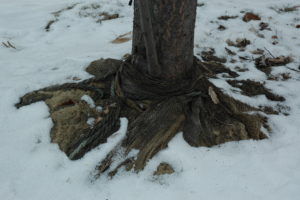The standards are filled with wonderful bits of information that we can use in order to sell jobs and educate clients. For this small discussion I’ll pull examples from part 8 of the standard which is Root Management.
Let me treat it this way. Trying to sell some root work to a client? Have your diagnostics brought you to the point of needing to go sub-grade to find the remedy?
Throw this out there for the win when a client needs a technical explanation, from section 80.2,
“The reasons for root management may include but are not limited to promoting tree health, stability, and longevity, and managing the interaction of tree roots with soil, infrastructure, property, and other plants.”
Who wouldn’t want that!
It’s an official statement that can be used as leverage in order to convey the importance of this management practice, and that ultimately carries a monetary value.
We see these many terms defined: surface root, soil volume, stem, tracing, root collar, buttress root and girdling root. As arborists we can use these terms in our estimates, reports and conversations with our clients: tree owners and property managers, municipalities and architects and artists all the same. Being able to define these terms give our suggestions weight, and like a tall tree we gain leverage by staying deeply rooted in the pertinent language of our trade.
There is a flowchart also offered as a resource we can use in our presentations and litigations.

Page 10 of the A300 ANSI standard- Part 8
In the standard we can find objectives, different approaches and practices to Root Management: how to inspect, how to examine and even how to cut. There is direction management and post-care practices.
In Annex A, there are a few alternatives listed to avoid root pruning and cutting. In the Z’s language, they can include but are not limited to:
Changing project design; Tunneling around or beneath roots; Re-routing utility lines away from roots; Tree grates; Bridging over roots; Discontinuous footings for retain walls, footing and foundations; Ramping sidewalks; Using flexible paving materials or shallower sections; Using permeable paving materials; Enlarging tree wells (cut-outs) or converting them to open retaining walls; Reducing sidewalk width; Relocating pavement; Increasing thickness of the pavement; Reinforcing with rods or under-laying it with a geotextile fabric; Use of georgics or other ‘no-dig’ pavement systems; Supporting pavement on piers; and, Covering surface-roots with soil or mulch.
So there are plenty of options offered too, if someone is looking for them.
I’ve heard it many times that the standards are for writing specifications for jobs and reports. In fact the mission is clearly stated at the beginning of the text, “to develop consensus performance standards based on current research and sound practice for writing specifications to manage trees, shrubs, and other woody plants” (7). But the more I read the standards, the more I also learn about trees and about the business of trees.
For the outsider looking in, wondering what it is that an arborist does exactly, the standards say it all. It’s who we are, and it damn well better be what we’re doing.
Word to Da’ Z yo.





Leave a Reply
Your email is safe with us.